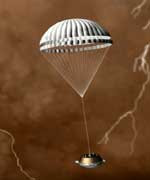A University of Colorado at Boulder-built instrument riding on the Cassini-Huygens spacecraft is being used to distinguish objects in Saturn’s rings smaller than a football field, making them twice as sharp as any previous ring observations.
Joshua Colwell of CU-Boulder’s Laboratory for Atmospheric and Space Physics said the observations were made with the Ultraviolet Imaging Spectrograph, or UVIS, when Cassini was about 4.2 million miles, or 6.75 million kilometers, from Saturn in July. Saturn orbits the Sun roughly 1 billion miles from Earth.
Colwell and his colleagues used a technique known as stellar occultation to image the ring particles, pointing the instrument through the rings toward a star, Xi Ceti. The fluctuations of starlight passing through the rings provide information on the structure and dynamics of the particles within them, said Colwell, a UVIS science team member.
He likened the Saturn system to a mammoth phonograph record, with the planet in the middle and the rings stretching outward more than 40,000 miles, or 64,000 kilometers. The size of the ring particles varies from dust specks to mountains, with most ranging between marbles and boulders, he said.
The Cassini observations show dramatic variations in the number of ring particles over very short distances, Colwell said. The particles in individual ringlets are bunched closely together, with the amount of material dropping abruptly at the ringlet edge.
“What we see with the new observations is that some of the ring edges are very sharp,” said Colwell. The sharp edges of small ringlets are especially evident in the C ring and in the so-called Cassini Division on either side of the bright B ring, Saturn’s largest ring.
The Cassini observations with UVIS show that the distance between the presence and absence of orbiting material at some ring edges can be as little as 160 feet, or 50 meters, about the length of a typical commercial jetliner, he said.
The sharp edges illustrate the dynamics that constrain the ring processes against their natural tendency to spread into nearby, empty space, said Colwell. “Nature abhors a vacuum, so it is likely gravity from a nearby small moon and ongoing meteoroid collisions confine the particles in the ring.”
Colwell presented his findings at the 36th annual Division of Planetary Sciences Meeting held in Louisville, Ky., Nov. 8 to Nov 12.
The stellar occultation process using UVIS also shows very high-resolution views of several density waves visible in the rings, including a previously unstudied one, he said. Density waves are ripple-like features in the rings caused by the influence of Saturn’s moons — in this case, the small moon, Janus.
“Small moons near Saturn’s rings stir the ring particles with their gravitational pull,” Colwell said. At certain locations in the rings, known as resonances, the orbit of a particular moon matches up with the orbit of certain ring particles in a way that enhances the stirring process, he said.
The density waves, which resemble a tightly wound spiral much like the groove in a phonograph record, slowly propagate away from the resonance toward the perturbing moon, he said. “This can create a wave in the ring that looks like a ripple in a pond,” said Colwell.
“The shapes of these wave peaks and troughs help scientists understand whether the ring particles are hard and bouncy, like a golf ball, or soft and less bouncy, like a snowball,” Colwell said. He noted that a density wave analysis by scientists involved in NASA’s Voyager 2 mission that visited Saturn in 1981 were used to determine the mass and thickness of the planet’s rings.
The Cassini-Huygens mission is a cooperative project of NASA, the European Space Agency and the Italian Space Agency. The Jet Propulsion Laboratory, a division of the California Institute of Technology in Pasadena, manages the Cassini-Huygens mission for NASA’s Science Mission Directorate in Washington, D.C.
CU-Boulder Professor Larry Esposito of LASP is the principal investigator for the $12.5 million UVIS instrument, designed and built for JPL at CU-Boulder.
Original Source: CU Boulder News Release

